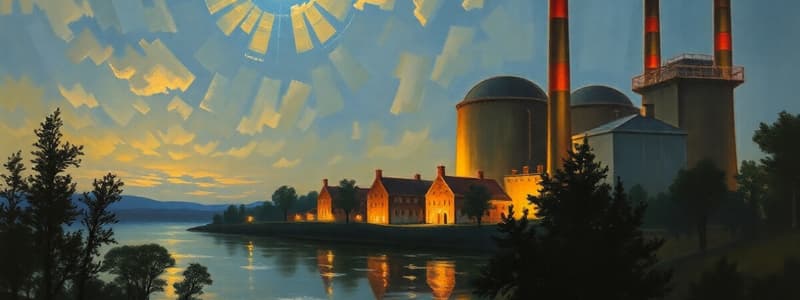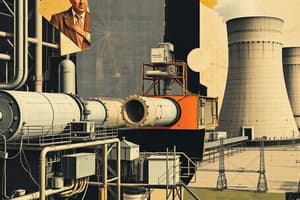Podcast
Questions and Answers
What is the primary focus of Week 1 in the syllabus?
What is the primary focus of Week 1 in the syllabus?
- Introduction to nuclear systems (correct)
- Nuclear reactor types
- Reactor kinetics
- Plant control functions
Which of the following reactor types is NOT mentioned as part of Week 2's focus?
Which of the following reactor types is NOT mentioned as part of Week 2's focus?
- BWR
- PHWR (correct)
- PWR
- CANDU
What percentage of the final grade is attributed to the final examination?
What percentage of the final grade is attributed to the final examination?
- 40%
- 50%
- 30% (correct)
- 20%
Which energy transfer method is covered in Week 3 of the syllabus?
Which energy transfer method is covered in Week 3 of the syllabus?
What is the total weight of coursework in the assessment methodology?
What is the total weight of coursework in the assessment methodology?
Which topic addresses the control functions for major components in a nuclear system?
Which topic addresses the control functions for major components in a nuclear system?
Safety principles in Week 6 focus on which of the following?
Safety principles in Week 6 focus on which of the following?
In terms of assessment methodology, what is the weight of lab reports?
In terms of assessment methodology, what is the weight of lab reports?
Flashcards
Nuclear Power Plant
Nuclear Power Plant
A nuclear power plant is a facility that generates electricity using nuclear fission. Major components include the reactor, steam generator, turbine, and generator.
Nuclear Reactor Types
Nuclear Reactor Types
PWR, BWR, CANDU, and VVER are different types of nuclear reactors. They differ in their design, fuel, and coolant.
Advanced Reactor Types
Advanced Reactor Types
Advanced PWR and BWR are newer versions of these reactor types, designed to be safer and more efficient.
Energy Transfer in Nuclear Plants
Energy Transfer in Nuclear Plants
Signup and view all the flashcards
Conduction
Conduction
Signup and view all the flashcards
Convection
Convection
Signup and view all the flashcards
Boiling and Flow Regime
Boiling and Flow Regime
Signup and view all the flashcards
Plant Control
Plant Control
Signup and view all the flashcards
Study Notes
Course Information
- Course title: NUCE 402: Introduction to Nuclear System and Operation
- Course instructor: Dr. Ahmed Alkaabi
- Course chapter: Chapter 1-1, Introduction to Nuclear System
Introductions
- Students are expected to:
- State their name
- Explain their reason for studying nuclear engineering
- Share their interest in nuclear engineering
- Discuss their post-graduation career goals.
Assessment Methodology
- Coursework: 20% (Includes daily quizzes, homework assignments, and a term project)
- Projects: 10% (if applicable)
- Laboratory: 20% (if applicable)
- Semester Examinations: 20%
- Final Examination: 30%
Teaching plan
- Week 1: Introduction to nuclear systems, concepts, and terminology for nuclear power plants.
- Week 2: Overview of nuclear power reactor types (PWR, BWR, CANDU, VVER) and advanced PWR and BWR, Gen-IV reactor.
- Week 3: Energy transfer in nuclear plants (nuclear reaction, heat generation, conduction)
- Week 4: Energy transfer in nuclear plants (convection, boiling, and flow regime)
- Week 5: Plant control: Basic control functions for major components, Reactor kinetics, temperature effects, and fission product poisoning.
- Week 6: Safety principles and protective functions in primary systems (reactivity, heat removal, radiation confinement, safety systems, and protective functions).
- Week 7: Safety principles and protective functions in secondary systems (heat removal, safety systems, and protective functions)
- Week 8: Midterm exam
Learning Objectives
- General description of a nuclear power plant
- Concepts and terminology related to nuclear power plants
Energy Equivalents
- A typical uranium pellet (7 grams, or 0.24 ounces) generates as much energy as:
- 3.5 barrels of oil
- 17,000 cubic feet of natural gas
- 1,780 pounds of coal
Nuclear Power Plant in Barakah (APR 1400)
- Detailed diagram of APR 1400 nuclear power plant components (Containment Building, Pressurizer, Steam Generator, Safety Injection Tank, Reactor Coolant Pump, Reactor Vessel, Diesel Generator, Main Control Room, Turbine Building, Moisture Separator Reheater, HP/LP Feedwater Heaters, Turbine/Generator, Feedwater Pumps, Fuel, Control Rods).
- Provides design and major features of the system, including system volumes, flow rates, temperatures, pressures, and cycle lengths
From Reactor to Home (PWR)
- Diagram illustrating the flow of energy from the reactor to the consumer (PWR)
- Highlighting the containment structure, pressurizer, steam generator, turbine, generator, and condenser.
Nuclear Power Plants
- Function: Utilize fission energy where nuclear energy transforms into thermal energy then into mechanical energy and finally into electrical energy
- Nuclear Steam Supply System (NSSS): This system is crucial in converting nuclear energy into steam.
- Steam System (or Balance of Plant): This is a part of the nuclear power plants responsible for generating electricity by utilizing steam. It includes components like turbines, generators, condensers, feedwater pumps, and more.
Principal Components of Nuclear Reactors
- Detailed diagram showing the core components of a nuclear reactor including; coolant in/out, control rods, reflector, thermal shield, coolant out, blanket/core/driver, shield and containment.
Non-Nuclear Components of NPP
- Diagram showing the non-nuclear equipment involved in generating electricity from a steam power plant.
- Emphasizing the components like high-pressure turbine, low-pressure turbine, moisture separator and reheaters, electrical generator, feedwater heaters. pumps, condensers and cooling water.
Components of Nuclear Power Plant
- NSSS: Reactor Pressure Vessel, Steam Generator, Pump, Pressurizer
- BOP: Turbine, Generator, Condenser, Feedwater Pump, Heat Exchangers, Moisture Separators
Studying That Suits You
Use AI to generate personalized quizzes and flashcards to suit your learning preferences.




